LIGHT LINE FLY FISHING FOR BUFFALO
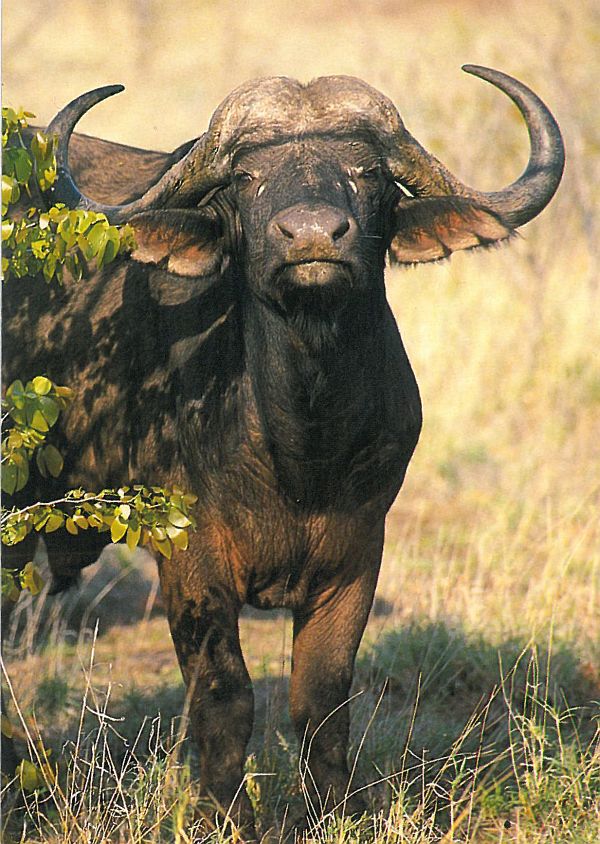
By JP Rigby
It’s been a while since I last wrote about buffalo and you know how things have changed since Koos Kieckstardt introduced his new light line big game fly rods, the Sweet Stampede Series (SSS). He makes these from hand-picked wattle, cut in the mountains around Komatipoort, where anyone who understands big game fly rods will tell you the best tight fiber wattle grows. It’s convenient, because Koos has shares in the Komatipoort hotel and often goes down to the pub to check how business is going, sitting for hours on the veranda in the shade of a marula tree dreaming up new rod tapers and checking to see they’re serving the beer cold enough.
Anyway, I happened to mention to Koos that I was having a real problem with buffalo lately because with so many guys fly fishing for them these days, especially on the popular beats, like the Stofkraal Corridor and the Malvlei Strip, they have got fly-shy and spooky, so to fool them you need lighter and lighter tackle, better presentations, smaller flies and all that stuff. And they’ve also gotten as selective as hell, taking only the smallest grass seed imitations, only the freshest green leaf shoots in the early mornings and late evenings, though I did get a keeper last week in the heat of the midday sun on a ripe guava imitation stripped carefully through the herd on a light tippet. Koos thought I maybe needed to go to a lighter line and a rod that delivers anything from real small grass seed imitations (say on 16/O hooks)to attractor patterns, like the late Buks Botha’s Bent Banana (the BBB), my favourite for early summer buff fishing.
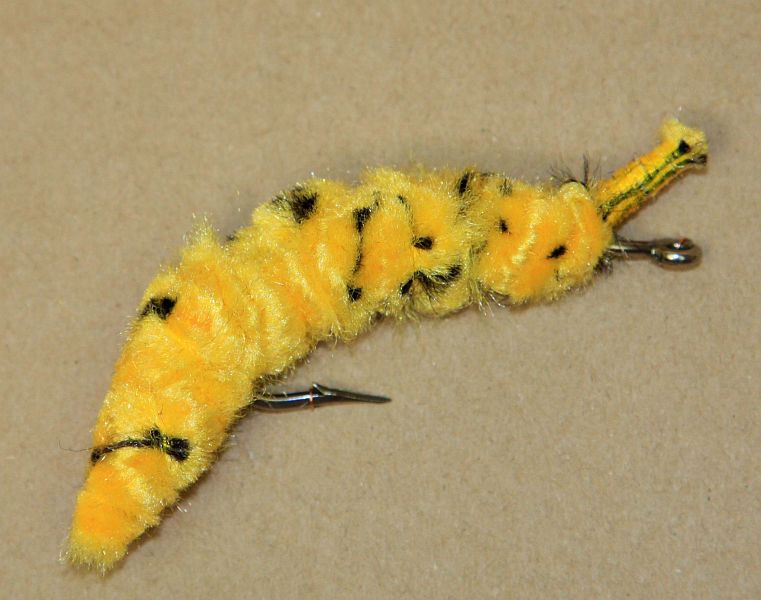
The Buks' Bent Banana (BBB) a great buff pattern
Koos showed me his new SSS rod tapers. They are revolutionary and he now makes the world’s lightest big game stick, a 15-wt, fast outselling the competition. I always loved Kieckstardt’s rods, but it seems he never got the recognition he deserved for his FU (Frankly Unbelievable) SSS series of rods, maybe because the guys were not living long enough to really talk too much about them.
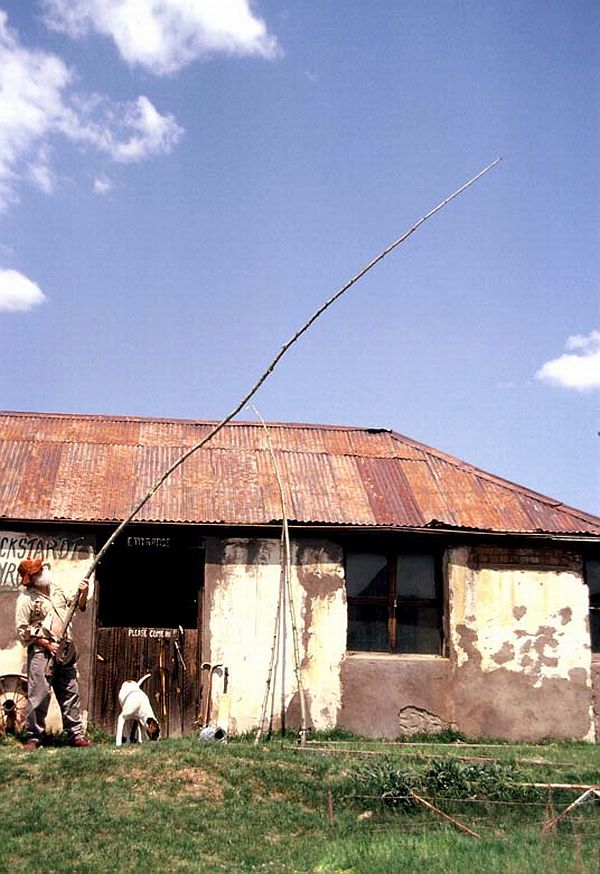
The famous Kieckstardt rod factory outside Komatipoort showing the rod builder and his hunting dog. Kieckstart has often been called the Pinky Gillum of the Bushveld. He’s also been called a lot of other names by many people.
This year will be different, because he has booked a stall on the Denver Fly Tackle Dealer show where the Americans can’t wait to see his new FU-SSS 15 rods, and his old, fast action PS series (Power Stick ®), not to mention his two classic videos, ‘Fishing Weed Imitations for Wading Buffs’ and ‘How to Fly Fish for Buffs and Survive It’.
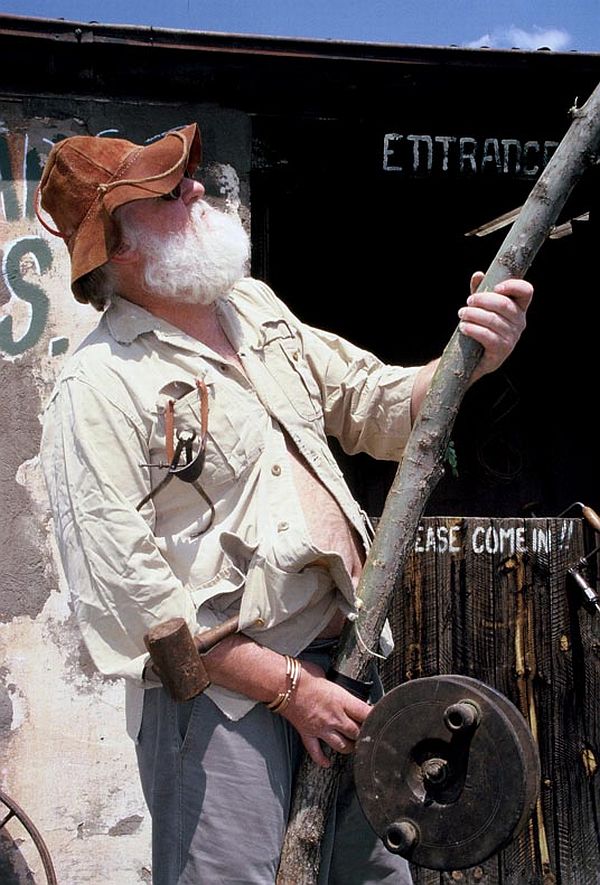
Koos with one of his earlier model Power Stick fly rods
(Contact Craig Thom of Stream X for copies of the Koss Kieckstardt videos- http://www.streamx.co.za/index.htm.)
The FU-SSS 15’s are something else. They are light as a brick, with just enough stiffness in the butt to really sink the hook and the soft tips are perfect for tight loops and delicate presentations, the sort that drop the fly as gently as a leaf falling from a baobab tree.
Koos has made his own Sweet Stampede fly lines especially for his new series rods, my favourite being the ultra-light, weight-forward #15. Even as little as a year ago who the hell would have thought we would be using rods as light as 15- weights on buffalo! Man, it blows your mind all this. Just yesterday it seems 20-wts were the rule! And Fred Vonk has designed a new furled leader to complement the SSS lines called ‘Vonk’s Finest Furled’ (VFF), hand wound from razor thin strips of elephant hide and tapered perfectly to reduce hinging. Vonk says there’s nothing worse than when your Bent Banana that won’t turn over properly, which is why he designed the 20 ft VFF. These are great and turn over well, but if you are fly fishing for crocs you need Kieckstardt’s braided wire tippets that he makes on a machine he just patented.
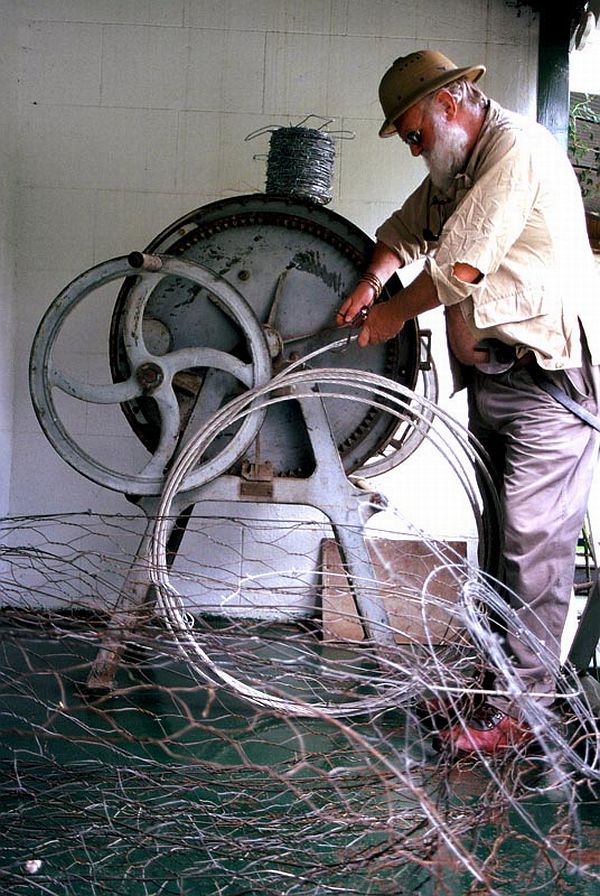
Kieckstardt making one of his celebrated braided wire croc tippets
That’s enough of plugging my mate Kieckstardt’s fly rods. Now let me tell you how to get a buff on light tackle. Most guys you talk to these days tell you that position is everything. Check out the herd carefully, from downwind or, if you have to be upwind, from the top of a tall tree. Failure to observe this basic rule can cause trouble; enough trouble to spoil the whole weekend. Keep your truck’s engine idling.
Check if the herd is feeding or just loitering around watching for lions and such. If they are feeding, check if they’re feeding on the surface on grass seed tips, green leaf shoots etc., or sub-surface feeding, like digging up roots and bulbs and so on, or getting into the water after fresh weed shoots.
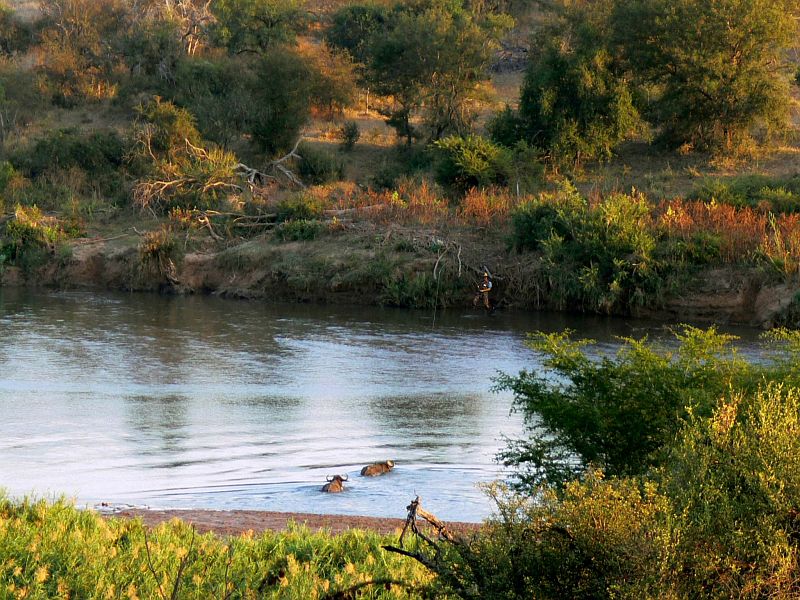
Angler on the far bank (it’s safer that side believe me) fishing a weed imitation with a slow Leisenring lift to buffs wading in the shallows. Note, the angler’s idling truck is concealed from view.
If you can’t make out their feeding pattern use polarized goggles. If they look like they are grazing go for one of the better known grass seed imitations, either tied fore and aft or spent wing. I’m still making up my mind about bright posts. I’ve seen them spook bigger buff.
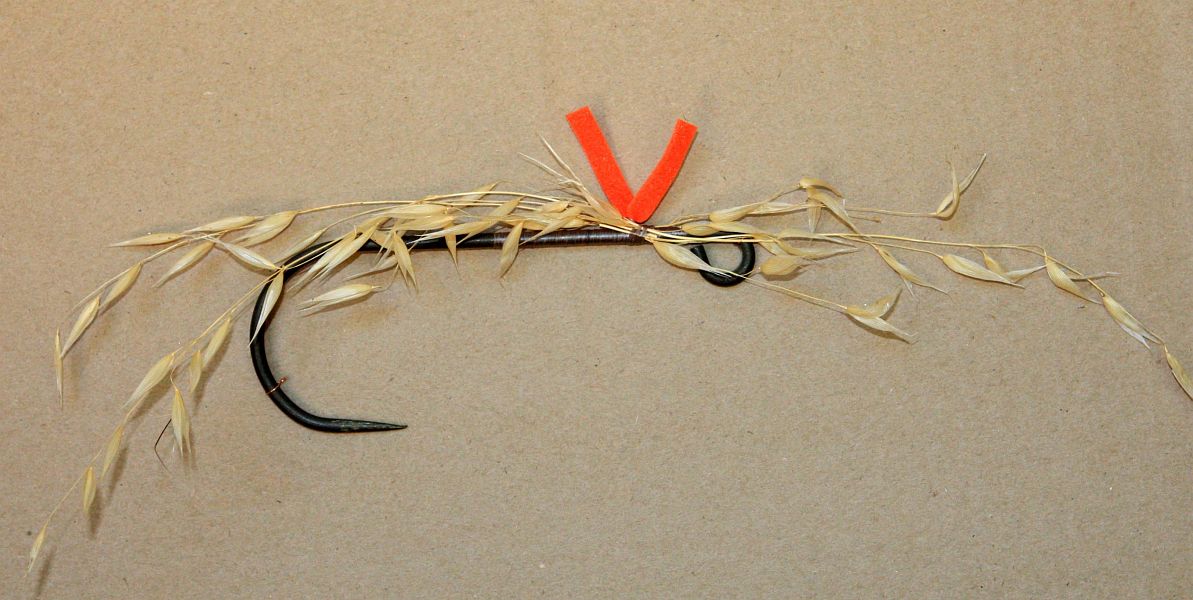
A sparsely tied Ripe Fore and Aft Grass Seed imitation with red spotter
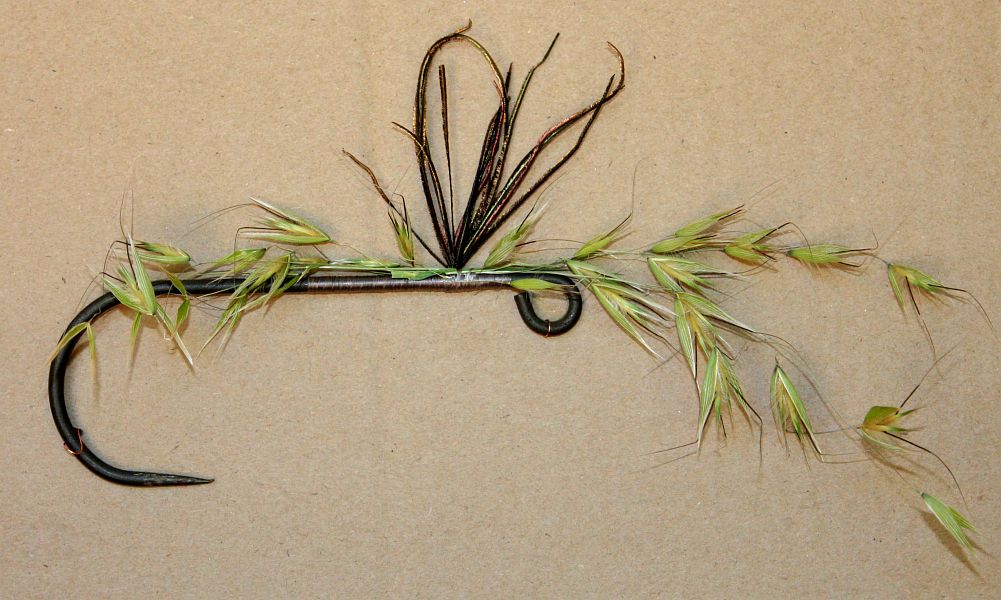
A sparsely tied Green Fore and Aft Grass Seed imitation with peacock herl spotter
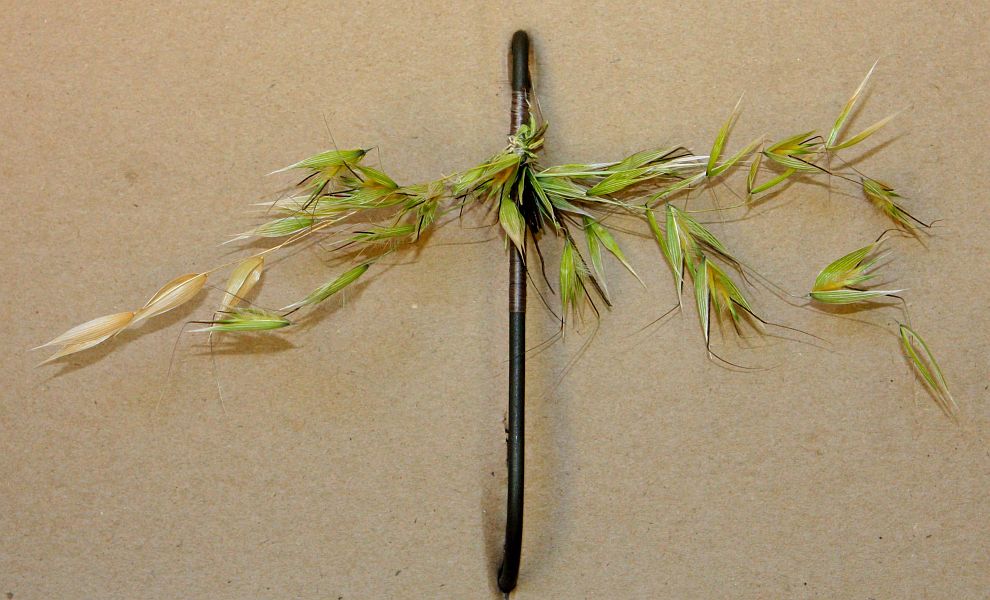
A sparsely tied Ripe Spent -wing Grass Seed imitation
Don’t get too close, don’t sneeze unless you really have to and don’t drink more than a few beers anywhere near buffalo. The two don’t mix that well. Did I mention to keep the truck’s engine idling?
Pick your buff and try to work out the direction of the graze, so you can lead him with a fly. Once you’ve done that, send four gillies up a tree with the landing net, pick a likely tree for yourself (for just in case) and prepare to cast. Put the fly down ahead of the animal without any false casting. A fly line in the air startles your average buffalo and you don’t want to startle buffalo unless you can’t really help it. If you’re using a grass seed imitation leave the fly and don’t retrieve it. If you are using an attractor pattern, like an Okkert’s Orange, or the now popular Rigby’s Ripe Granadilla (RRG) imitation, make them roll naturally with a steady retrieve. Buk’s Bent Bananas (BBBs) should be fished static, peeled or unpeeled. Personally I like the peeled version. (Available at Frontier Fly Fishing on back order. Remember to state the ripeness you want. http://www.frontierflyfishing.co.za/ )
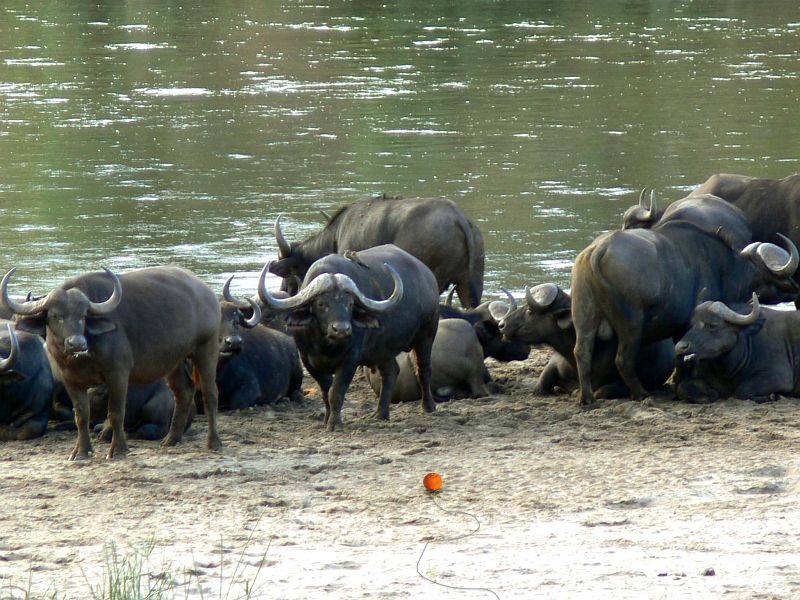
An Okkert’s Orange rolling naturally to the buff in the middle of the picture. Note his obvious interest. He took the orange, but we got no shots of the take due to bad camera shake and dust. (The buff I really wanted, though, was that one and a half ton trophy to the far right, but you can’t get a drag free drift to a buff grazing at that kind of angle even mending like mad.)
When the buff takes, try to let him turn his head before you sink the hook so when you strike he’s not looking in your direction because if he is, he will associate you with the sudden pain in his mouth and that can make life difficult for the angler.
Heavy clouds of red dust after the strike can be a problem, especially if the whole herd stampedes and for that reason I always wear a pair of motorcycle goggles and so do my gillies. And I keep the truck’s engine idling.
If the animal just hangs around grazing, or yawns after you strike it’s a sure sign he doesn’t know he’s hooked. It’s best then to lean into the rod butt and hit him really hard. If that doesn’t work, ask a gillie to run about in front of him wearing his goggles and waving his hat to get the message across. But if he winks at you watch out. It means he knows he’s hooked and he’s trying to fool you.
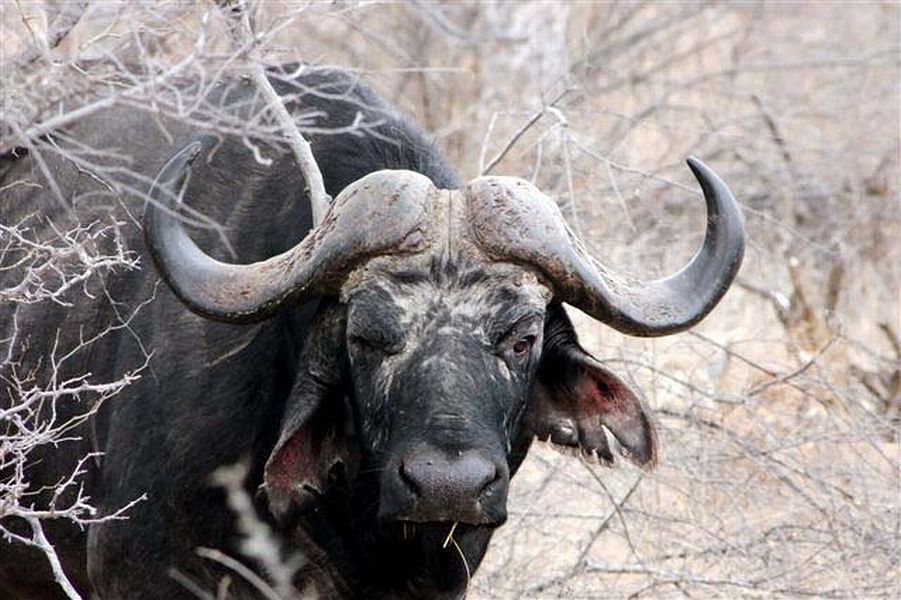
An ominous sign. This buff’ has eaten the fly, but note the wink!
Play the buff off the reel as soon as you can. Don’t leave loose line around because in the first few runs it will snag a bush or a loitering gillie and the animal or the gillie will break off.
Squeeze up the drag on your reel if the first gallop has stripped you to the backing. I still prefer my Purdey, or my Holland and Holland reels, especially with the new lightweight 15 lines because they easily take a thousand or so yards of fine cable wire backing. But the new Westley Richards large arbor reels are also good.
Koos will tell you to trust his rods and pump the buff as soon as he starts to tire, usually in less than an hour or two. If he holes up in some bushes and sulks, just keep even pressure on him and try to pump him out into the open or, if he won’t budge, give him slack and send in any gillie you don’t really like, to distract him into a charge. But if he just stands staring at you with his head dropped low, pawing the ground, winking, or drooling, watch out. This is a sure sign he does not like you and is not ready for landing yet.
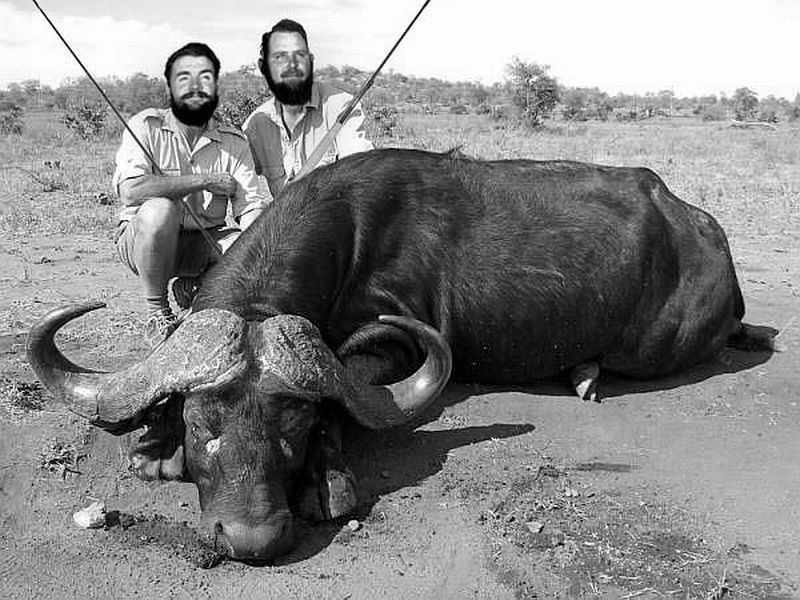
A keeper landed. JP Rigby (left) with Fearless A Fritchard, a one-time serious competition big game fly fisher until his nerves got to him
Once the buff has tired, get the gillies to throw a heavy duty seine net right over him. This usually trips up the buffalo, but life can get difficult if they miss the buff and you should not hesitate to climb your chosen tree when in doubt, or make for the truck. In fact this netting technique takes hours of practice and a good net throwing team is worth their weight in gold. My team has been with me for ages and they’ve got good enough to net passing cars on the R571 near where I live.
Once he’s down, speed in with the braai tongs or wire cutters and unhook the fly. Don’t attempt a quick stomach pump to see what the buffs been feeding on. Life’s too short. Take your snap shot, put a tape over the buff, shout “release”, and run like hell for the nearest tree, or the idling truck. After an hour or two the buff loses interest and you can take your goggles off, climb out the tree and make an escape.
A good day’s buff fishing, provided the wind doesn’t swing the wrong direction and the herd is feeding well, should see you net two, maybe three buffs, each weighing around a ton, or 10 feet long, though occasionally I’ve had them over 12 feet in the Stofkraal Corridor (where, incidentally, we have had big crocs on Rip Riphagen’s Sunken Guinea Fowl pattern fished on Kieckstardt’s handmade fine wire furled leaders and Bentley belt strike indicator).

A real youngster. Buffs like this must be returned.
Put back any buff under half-a-ton to grow out a little. If you want to keep a buff do so only if you plan to eat it. Otherwise catch and release is the name of the game.
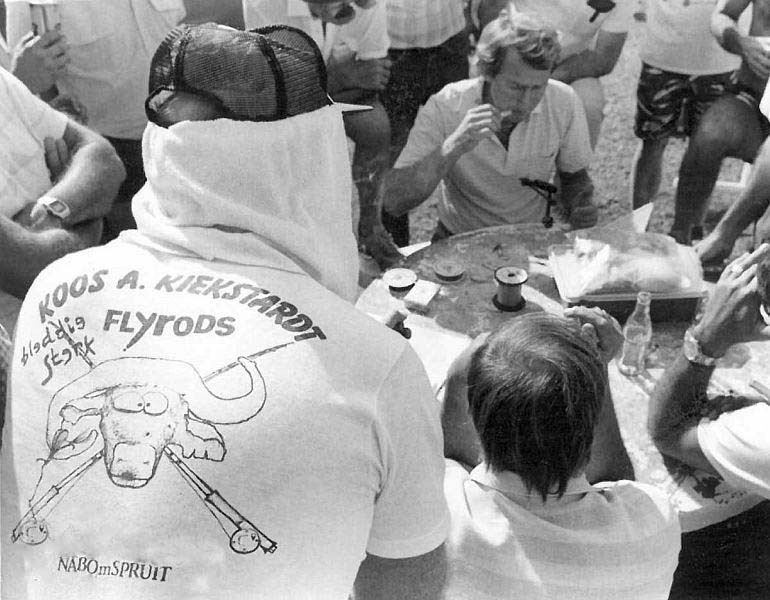
Demonstrating the tying of Ripe Grass Seed imitations at the Naboomspruit Fly Club
Editor’s note
JP Rigby is chairman of Naboomspruit Big Game Fly Fishers Club (NBGFFC), a member of KFC (Komatipoort Flyfishers Club) and a regular contributor to all the better fly fishing journals in the world. Readers wishing to correspond with him may do so after December 30th when he is expected to be discharged from the Nelspruit General Hospital. Write to him care of his attorneys, Nienaber and Sons, Notaries at Law and Agents for Harley Davidson Motor Bikes (Bushveld Division), Box XYZ 6 Komatipoort or call him on 04555555, but don’t forget it’s a party line.
(In future episodes, JP introduces us to crocs on attractor flies, hippo on floating water hyacinth patterns and warthog on half buried gladiola bulb imitations. His long awaited book, Big Game Fly Fishing isn’t for Sissies is expected out sometime in the near future. Long Horn Publications, 224 pages, 23 illustrations and 7 obituaries. Editor.)


